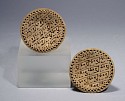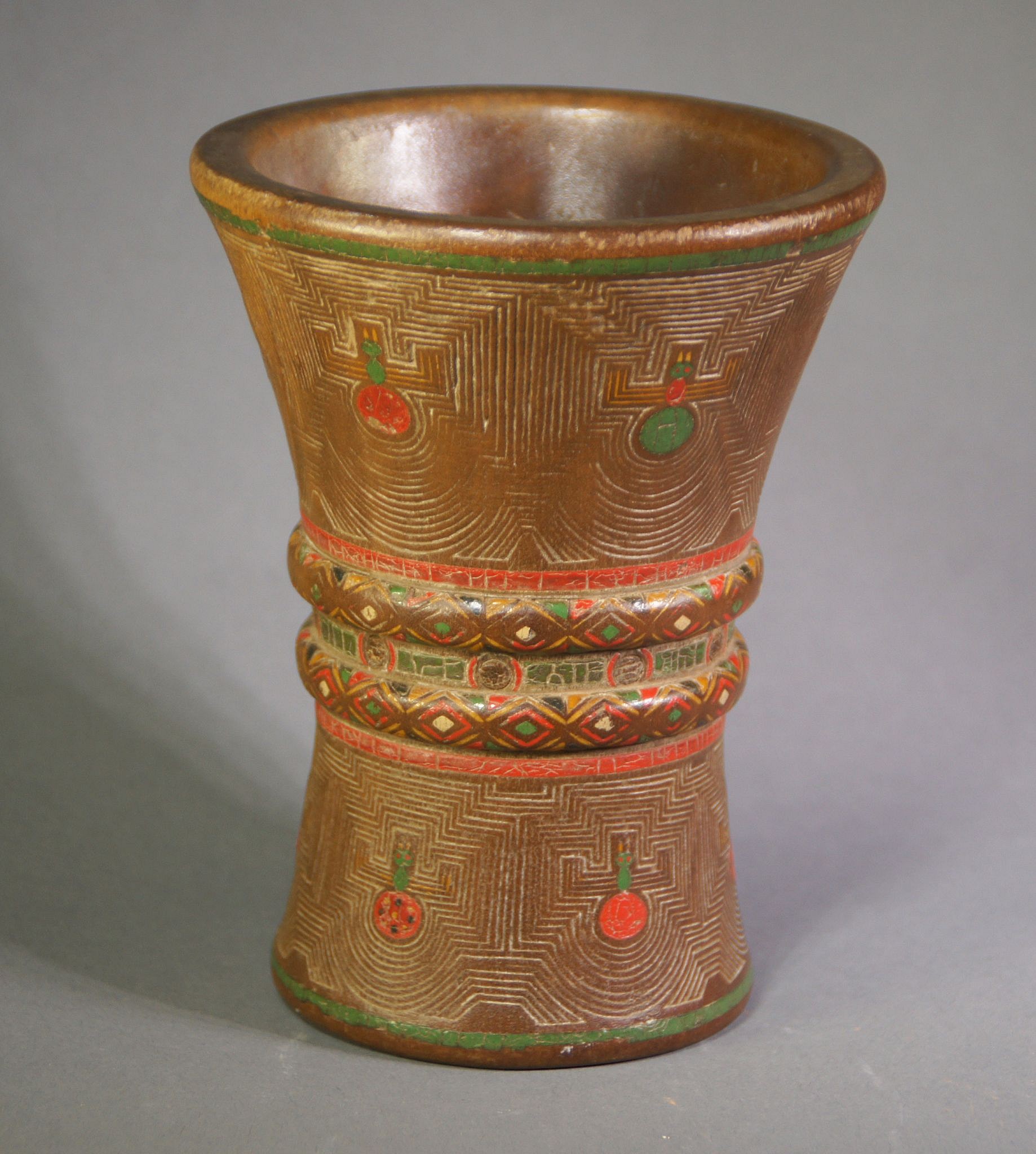




Peru, Inca Wood Polychrome Kero Incised with Spider and Geometric Designs
This kero is an extremely fine example of incising technique. The overall surface is incredibly intricate. The incision lines mimic the natural geometry imposed by the repeated motif of an abstract spider moving vertically on the upper and lower portions of the vase. The creature's body is highlighted with red, yellow and green paint. The central band is accented with patterned bands of diamonds and circles and squares in red, yellow, green, black and white. The rim and base are accented with simple green bands. Such great attention to linear detail and mastery of the incising technique suggests that this is an earlier kero (possibly 16th century). Examples illustrating the incising technique can be seen on p.54 of 'QEROS: Arte Inka en Vasos Ceremoniales', by Jorge Flores Ochoa. This book is part of the Coleccion Arte Y Tesoros Del Peru.
Period: Peru, Inka, Colonial Period, 1600-1800AD
Media: Wood
Dimensions: Height: 5 1/4"
$12,500
MM110
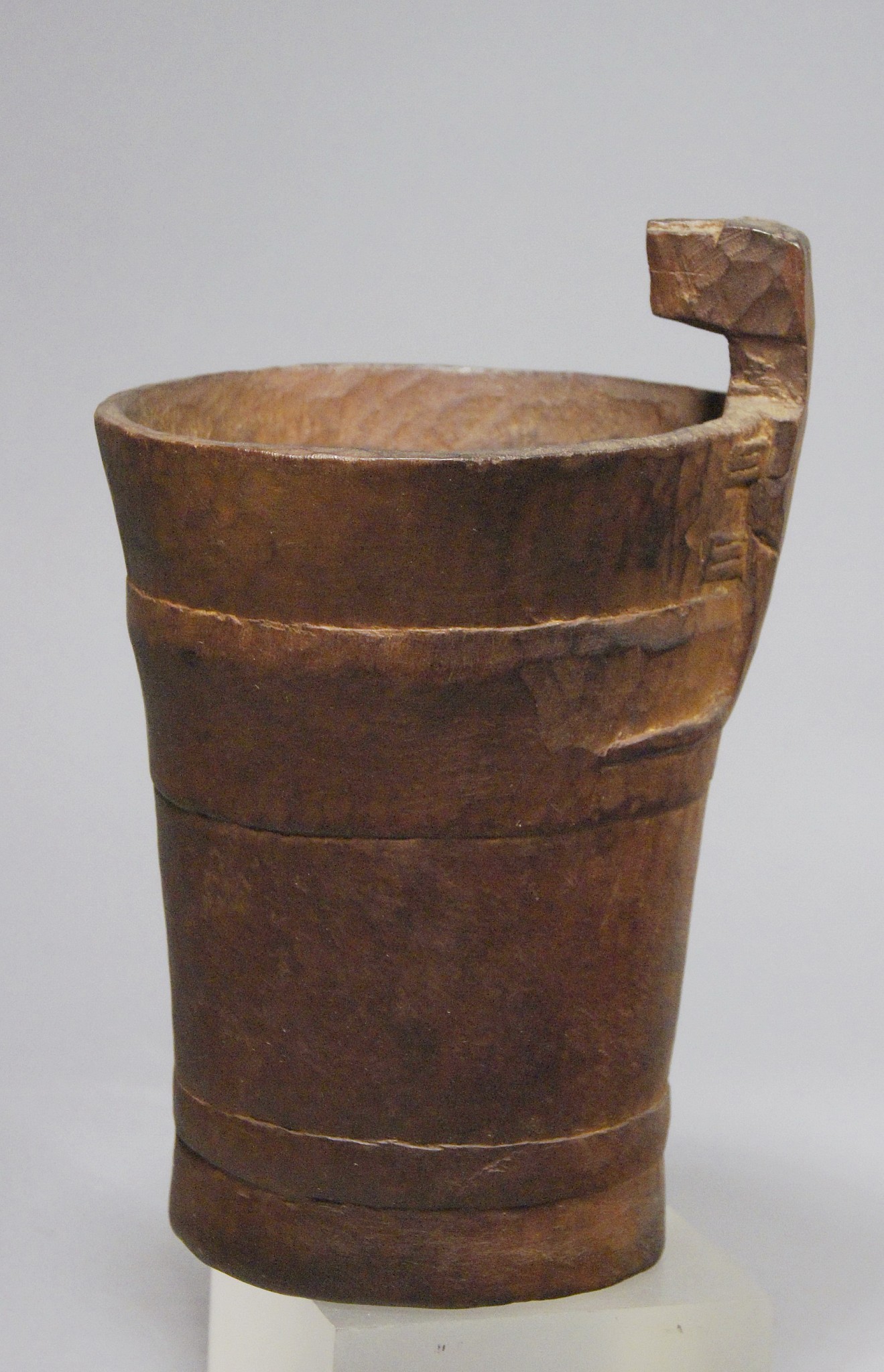




Chile, Arica Wood Kero with Lizard
This is a classic Arica cup, smoothly finished on the outside and roughly carved on the inside. A similar one has been exhibited and illustrated in the book "Arica, Diez mil Anos" (Museo Chileno de Arte Precolombino, 1991: fig. 050). Ricardo E. Latcham illustrates a cup of this type in "Arqueologia de la Region Atacamena: (1938: fig. 51). John Rowe describes these cups as the precursors to the classic Cuzco-style cups in his essay, The Chronology of Inca Wooden Cups in "Essays in Pre-Columbian Art and Archaeology" (1961: 317-341). The first example style kero was found by Gilliss and illustrated in the "U.S. Naval Astronomical Expedition to the Southern Hemisphere." (1856: III: pl. X).
Period: Chile, Arica, San Miguel, Phase North Coast, circa AD1100-1200
Media: Wood
Dimensions: Height 5 1/2" x Width 4 1/2"
$2,300
97133B
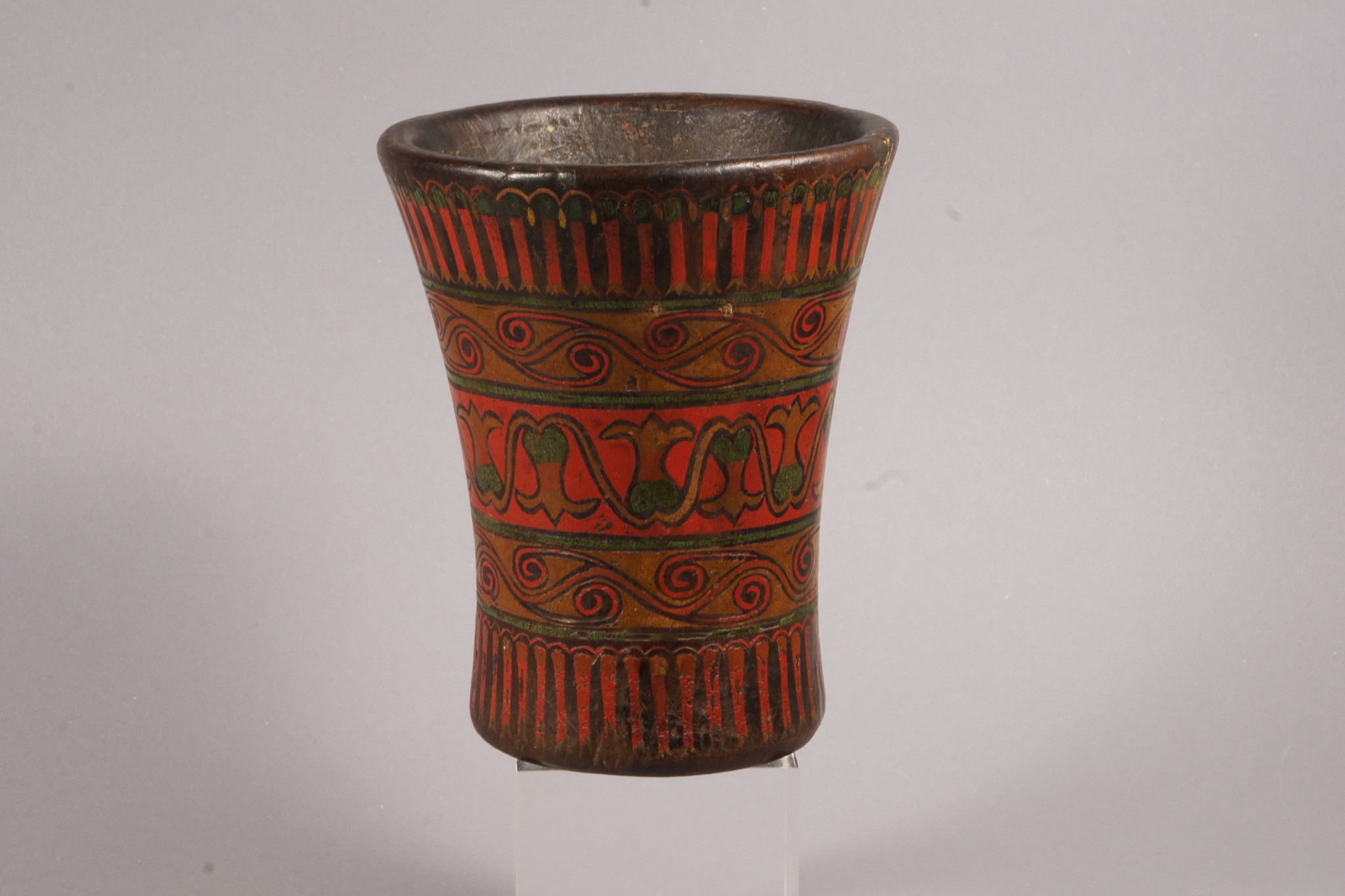



Peru, Colonial Qero with floral motifs in registers
Decorated in five registers with flowers, the pair to this vessel is in the Museo Inka, Universadid Nacional del Cuzco and illustrated in Ochoa et. al. "Qeros: Arte Inka en vasos ceremoniales" (1998: 267). Some were made in pairs, particularly in the Colonial period. Qeros were festive drinking cups that Inca rulers, governors and other state officials used in ceremonies, and they were often gifted from one lord to another. Hans Monheim collection - Aachen Germany since 1950's.
Period: Peru, Inca, Colonial Period, circa AD1600-1800
Media: Wood
Dimensions: Height 6 1/2: x Width: 5 " across the top
Price Upon Request
M4044
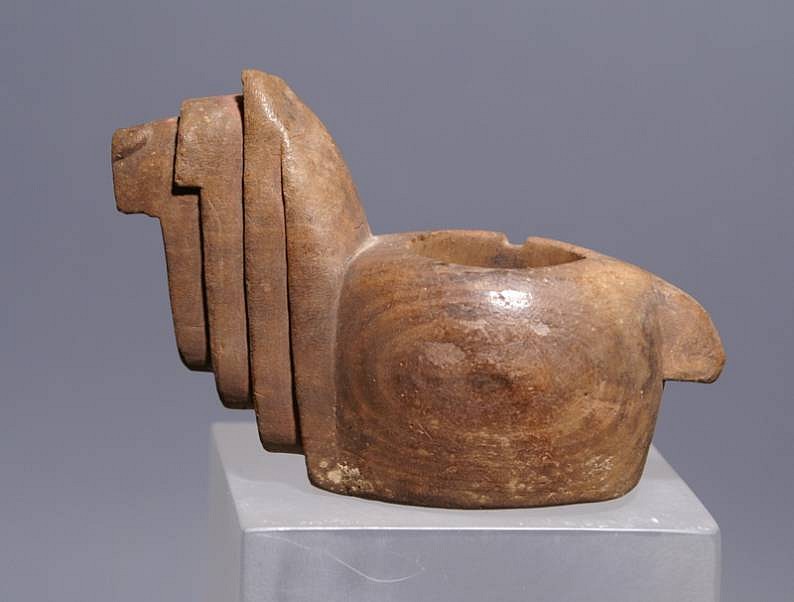





Peru, Wari Carved Wood Konopa in the form of an alpaca
Konopas were sacred offering containers carved in the shapes of llamas and alpacas. This example is carved from balsa wood in the unmistakable form of an alpaca, distinguished by its long hair, especially flopping over the eyes. A round cavity was carved into the animal's back for the purpose of holding an offering. Once filled, probably with a mixture of llama or alpaca fat and blood, the carving was subsequently placed in pastures to secure the fertility of herds and the land, both so essential to the ancient Peruvians. Most known extant konopas are from the later Inca period and were generally carved from stone. A wide variety of Inca stone examples are illustrated in "Gold of the Andes: The Llamas, Alpacas, Vicunas and Guanacos of South America," 2 vols. (Barcelona, 1994, Vol. I: 20 and 21). The stone Inca examples of alpaca konopas are from Helmut Schindler "The Norbert Mayrock Art Collection from Ancient Peru" (2000: 320).
Period: Peru, Wari, South Highlands, circa AD650-1100
Media: Wood
Dimensions: Height 2 1/2"
Price Upon Request
94016
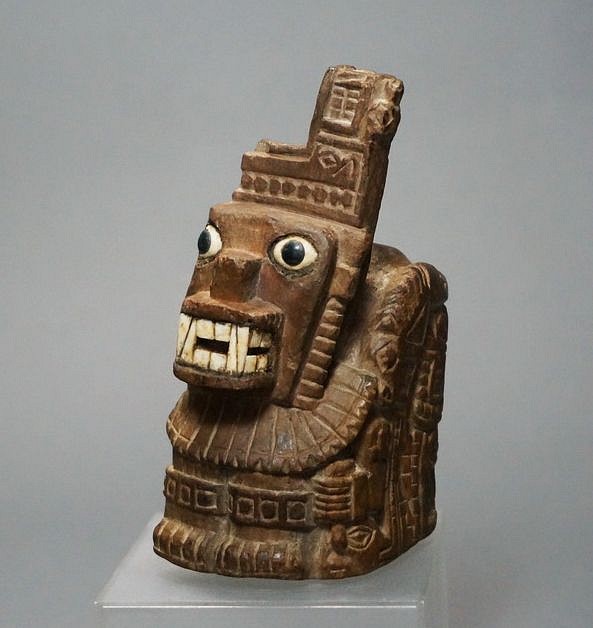




Peru, Large Wari Carved Wood Lime Container Representing a Decapitator
This large wood lime container is carved in the form of a classic Wari decapitator holding a trophy head in his right hand. These containers were used to store lime, which assists the body in metabolizing cocaine alkaloids from ground coca leaves. The opposite side would have had him holding a tumi knife. The decapitator is wearing an elaborate costume with a puma mask and a tapestried tunic with feline profile faces. Below the mask is an elaborate pectoral of trapezoidal plaques. One half of the container is missing, and the inside reveals a storage chamber. The puma is elaborately decorated with classic Tiahuanaco motifs from the Gateway of the Sun. Evidence of inlays in the eye sockets exist. The container portrays a major sculpture in wood for this period. Another lime container in the National Museum of Copenhagen of the same height, 5.75" is illustrated in "Art of Empire, Museum of Primitive Art" - fig. 80.m. There is a chapter in the Peruvian publication Los Dios del Antiguo Peru - Dioses De Pachacamac El Idolo Y el Templo, pages 159-175, which discusses a carved wood idol on a staff. This staff in the book has many elements that are similar to this lime container, specifically the arched serpent and profile face.
Period: Peru, Huari South Highlands/Coast, circa 650-900A.D.
Media: Wood
Dimensions: Height: 4 1/2"
$8,000
97158
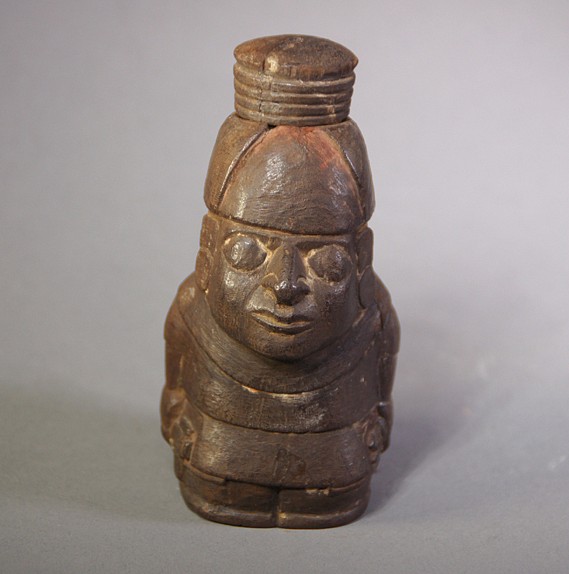




Peru, Large Wari wooden lime container in the form of a seated man
This large Wari wooden lime container is in the form of a kneeling figure carrying an axe in one hand and a group of darts in the other. He wears a circular hat which is also the lid of the container and a pair of earspools.
Period: Peru, Wari South Coast, circa AD650-900
Media: Wood
Dimensions: Height 4 3/4 in.
Price Upon Request
93123
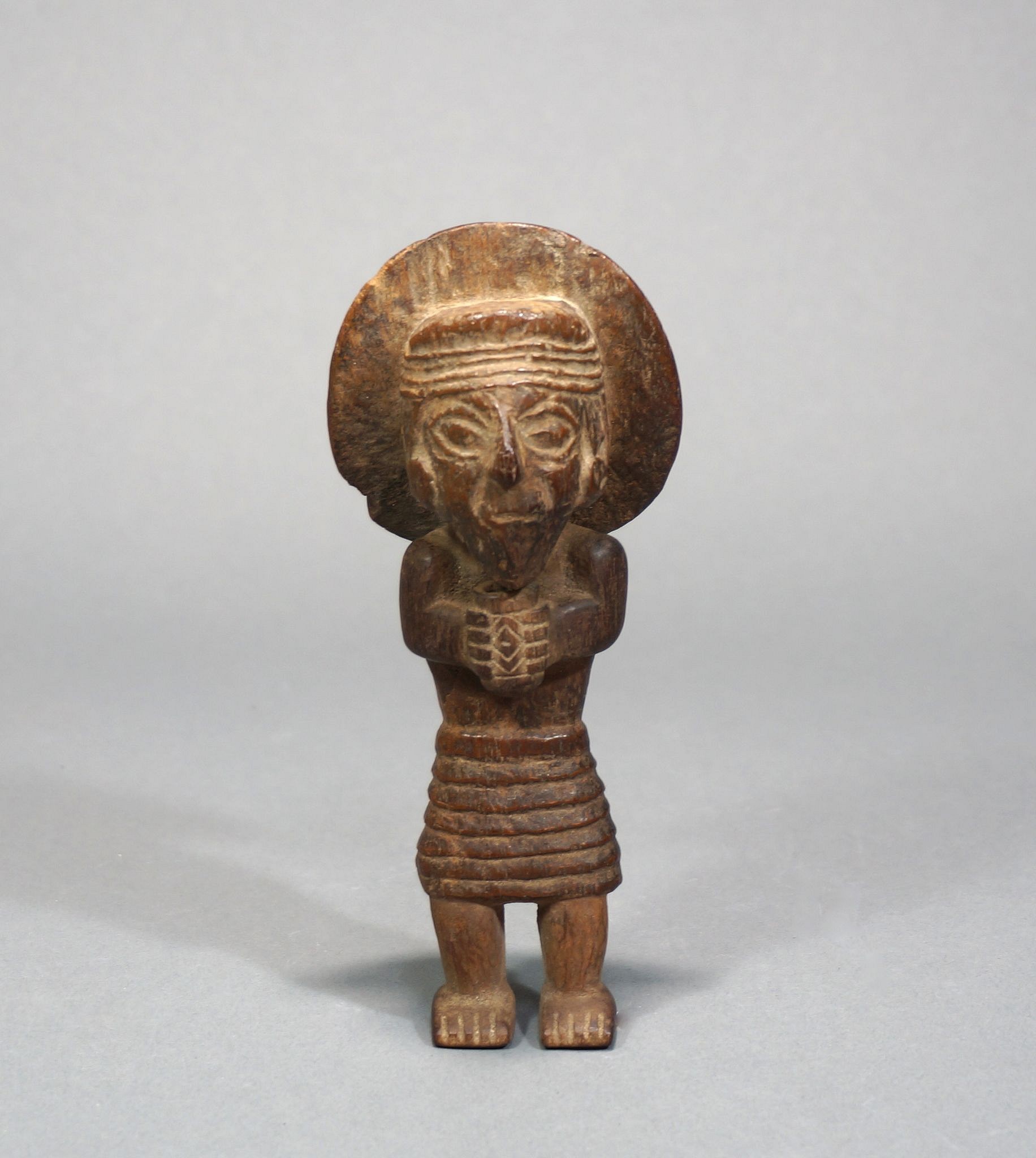




Peru, Wooden Man
Effigy figure of a high status individual wearing an unusual circular feather head dress and holding a kero. The shirt is also unusual, with a multi-layered construction.
Media: Wood
Dimensions: h: 5 3/4"
Price Upon Request
n4004
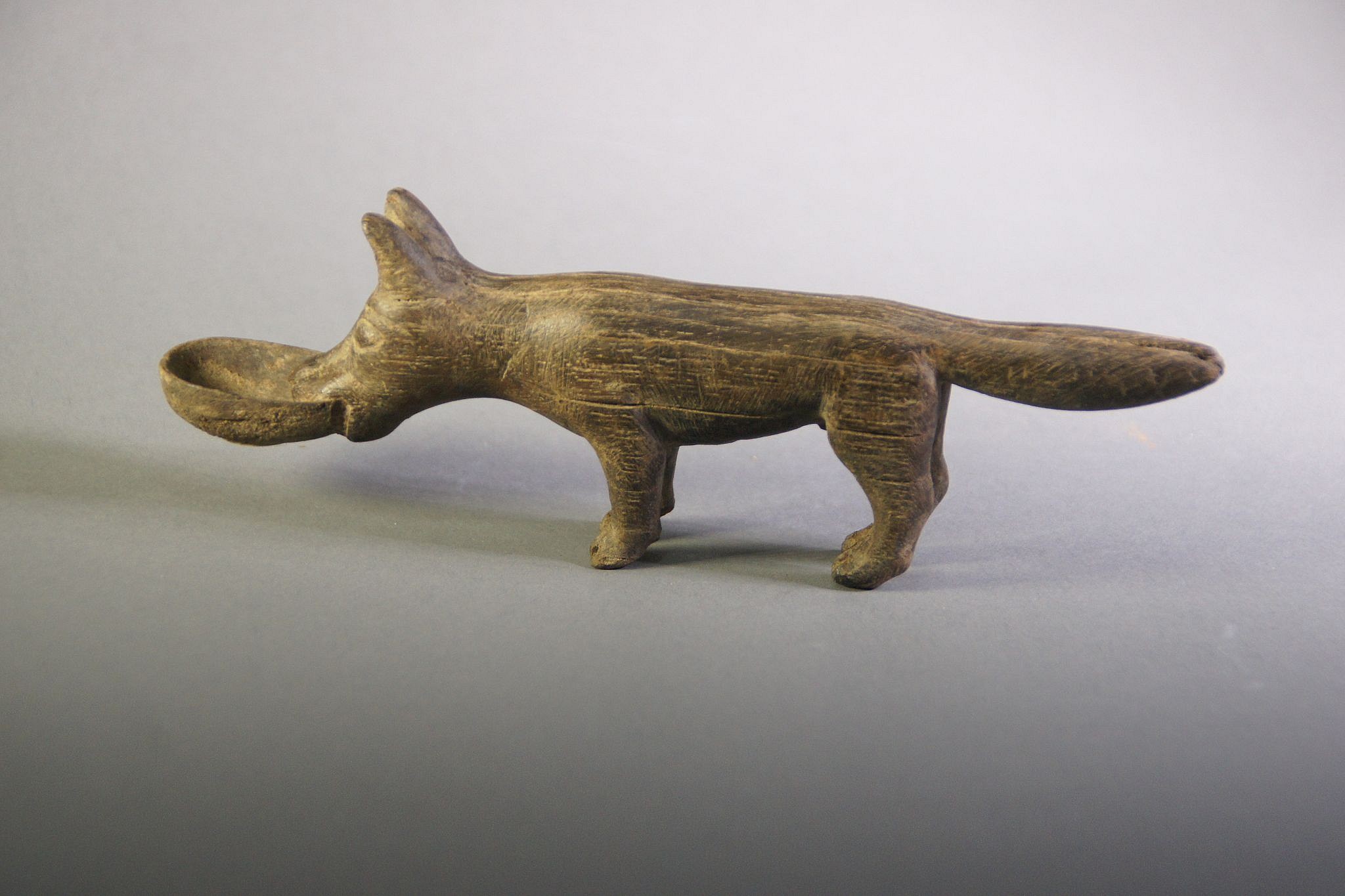



Peru, Wari Carved Wooden Dog with Bowl in Mouth
The dog has a fluffy tail and is holding a bowl in its mouth, asking for food.
Period: Peru, Wari South Coast, circa AD650-900
Media: Wood
Dimensions: Length: 7"
Price Upon Request
N3033
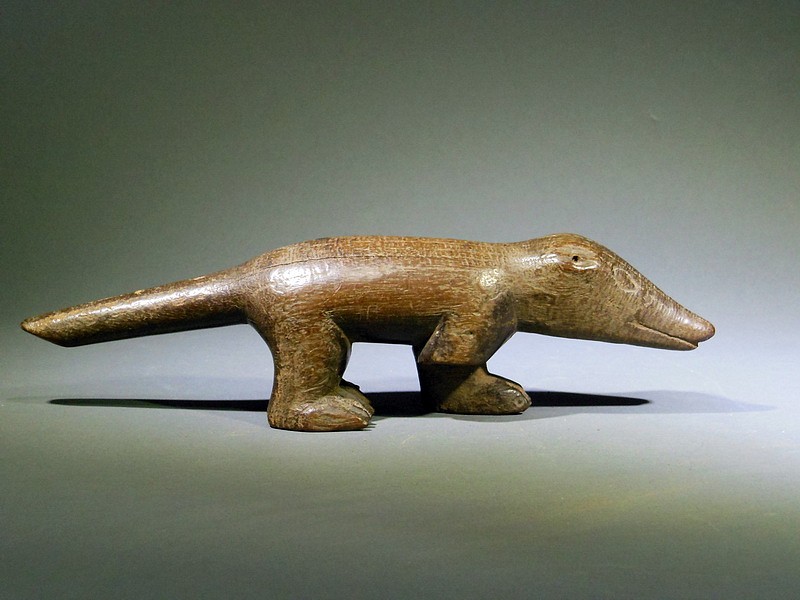


Peru, Wari Carved Wooden Oppossum with Leg Missing
This opossuml has large feet, a long tail and a long snout. He has ears which are are extremely short. His back feet have prehensile thumbs.
Period: Peru, Wari South Coast, circa AD650-900
Media: Wood
Dimensions: Length: 9 1/4"
Price Upon Request
n3032
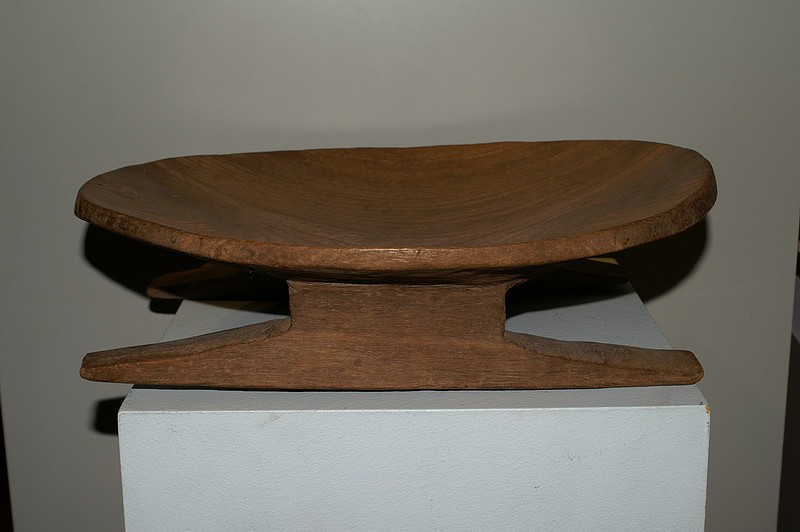





Peru, Inca Tiana Carved Wooden Seat
Tianas were originally made from a single block of wood during Inca times (1250-1500AD). These wooden seats and other specified goods were limited for use by the Inca class. Tianas continued to be used well after the Spanish conquest. A well known Tiana survives in the Berlin Museum.
Period: Peru, Inca, South Coast, circa AD1200 -1532
Media: Wood
Dimensions: Length 14' x Width 11" x Height 4"
$8,000
M7012
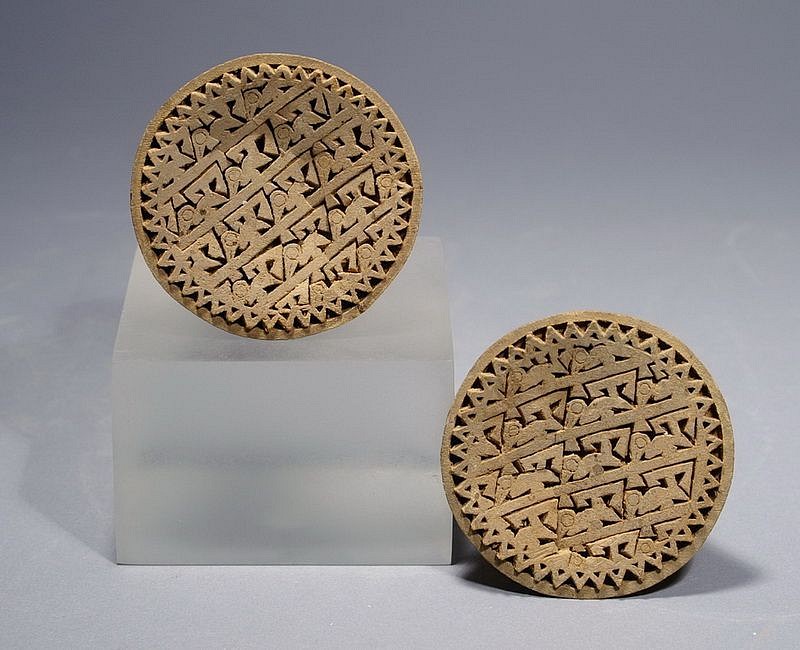



Peru, Central Coast Peruvian Wood Ear Spools
Probably late Huari or early Chancay, these light balsa wood ear spool carved in three sections, depicting a face, body and back. The design is cut out, with four rows of birds in profile – generally typical of Chancay or Chimu art. No glue or tree resin was used to keep the three sections together, rather they are carved perfectly to have a precise fit. Ear spools were used in the ancient Andes to display status and rank. Ex. Daniel Rifkin, acquired in New York prior to 1980.
Period: Peru, Wari, Central Coast, c. AD 650 - 1100
Media: Wood
Dimensions: Diameter: 3" x Depth: 4 1/2"
Price Upon Request
M4011




Peru, Nazca Wooden Blow Gun with Wrappings
The blow gun is made from one solid piece of wood. It is stone-carved on the inside, and drilled from the narrow center section to the mouth piece. There are very few examples illustrated in the material culture of ancient people using blow guns for hunting, except for one famous example on a Moche mouth ornament, illustrated in the Dora and Paul Janssen collection catalog "MASTERS OF THE AMERICAS" on page 254. In this example, two hunters are using short blow guns to kill birds on tree branches with cactus thorn darts. This particular blow gun was found with a fancy double weave cloth fragment and fine yellow feathers strung together - perhaps to decorate the blow gun or used for camouflage. Tree thorns were also found at the site, probably for use as darts.
Period: Peru, Nazca, Late phase, South Coast, circa AD600-800
Media: Wood
Dimensions: Length: 18 1/4" Diameter at End: 2 1/2"
Tapers to: 1 1/4"
Price Upon Request
n2045
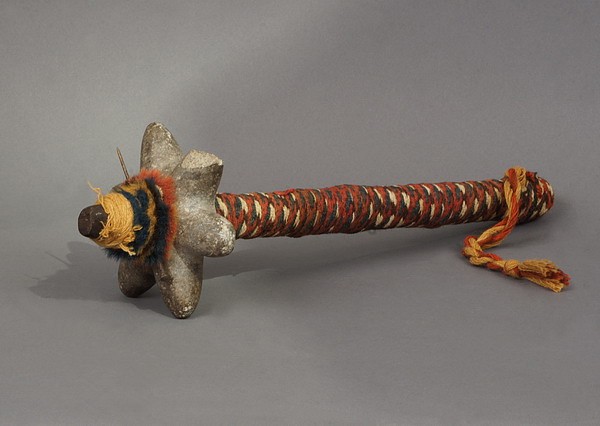


Peru, Club with Six-pointed Stone Mace
This wood handled club is decorated with a colorful alpaca band and topped by a six-pointed stone mace. The mace is secured to the shaft with a bronze needle and a colorful fur-like band. Clubs were favored in the Andes because the Andeans utilized a clobbering form of fighting and hunting as opposed to hunters in Europe, who preferred a piercing technique with hardened metals. There is an example illustrated on a Moche painted ceramic that depicts a deer hunt, in which hunters are using both clubs and darts. The illustration appears in "MOCHE: ART OF PERU" by Christopher Donnan, fig. 263.
Period: Peru, Ica/Chincha, South Coast, circa AD1000-1450
Media: Wood
Dimensions: Length: 16" Diameter of Macehead: 5"
Price Upon Request
n2046
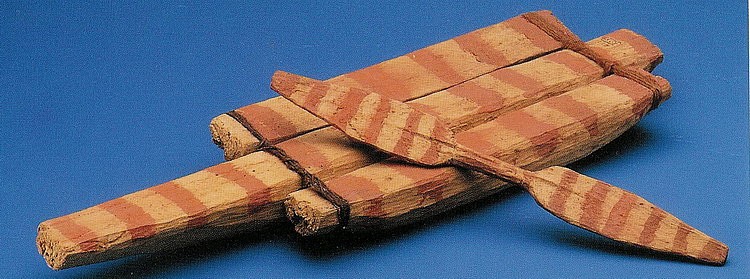
Chile, Small Chilean Arica Model Raft with Oar
This very rare model is intact with its original sea-lion leather lashing and double sided oar. These models are found in tombs and suggest that the deceased person was a sailor. This model is painted with red pigment. It is a small example but it is in excellent condition. The model is similar to one found in "THE INKA EMPIRE AND ITS ANDEAN ORIGINS" by Craig Morris.
Period: Chile, San Pedro de Atacama, circa AD300-900
Media: Wood
Dimensions: Length 10" x Width 3 1/4"
Price Upon Request
98095
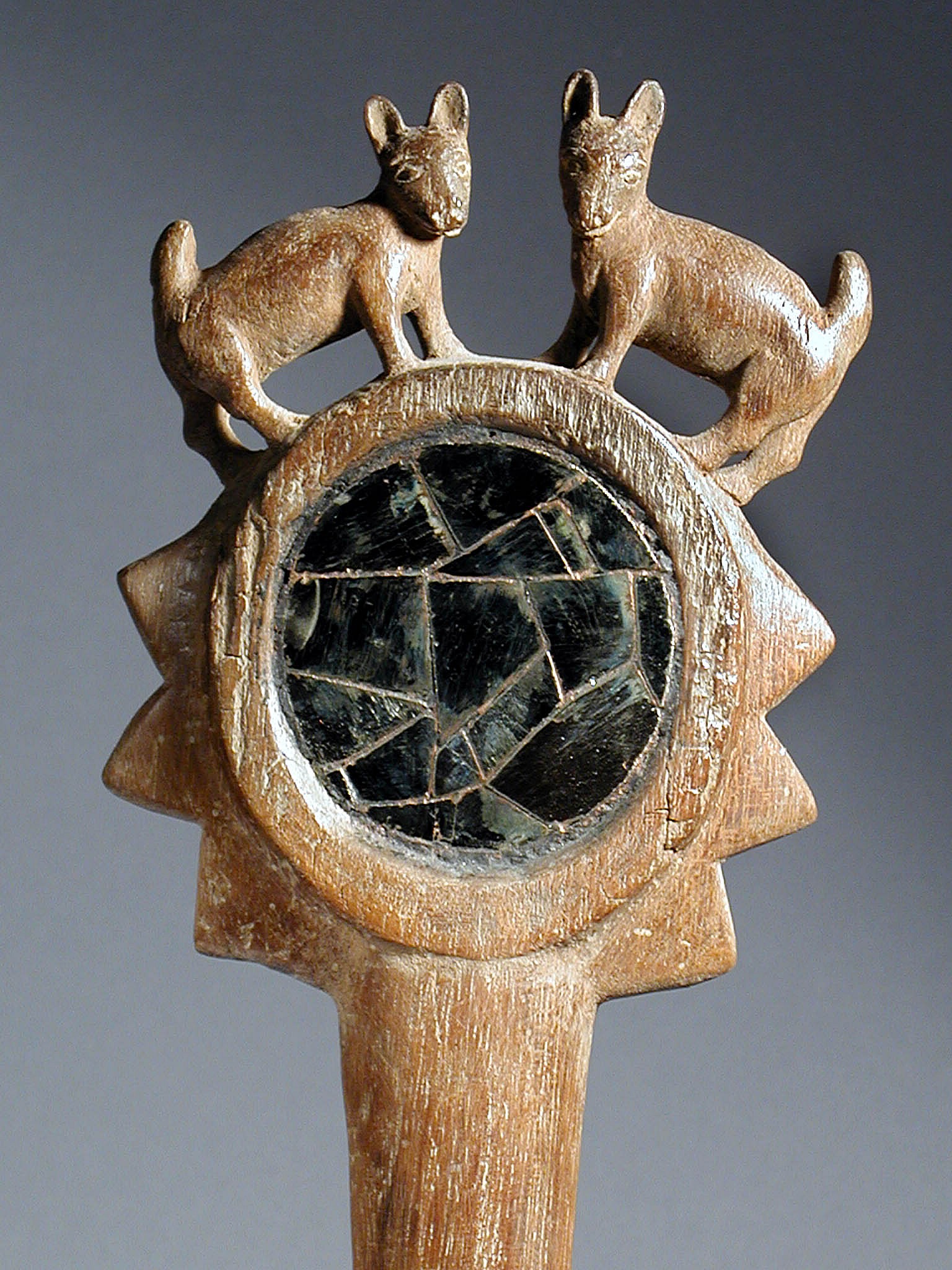


Peru, Wari Long Handle Wood Mirror Back with two deer carved on top
Elegantly carved wood handled mirror decorated with two felines perched on top facing outward. The mirror frame is carved with a mace-like knobs to give an overall impression of a scepter. The verso side is plain.
Period: Peru, Wari, Central Coast, circa AD650-1100
Media: Wood
Dimensions: Length 14 1/4"
Price Upon Request
94189




Peru, Chavin carved wood effigy of a shaman
Carved wooden effigy of a standing shaman holding a flute or serpent in front. The shaman has puckered lips as if he is whistling and appears in a trance like state. He is wearing a headdress, v neck tunic and belt with two long devices hanging down along the outside of each leg. On the back of the belt is a "U" shaped device of unknown use. From the top of the head emeniates a bone tube which has been broken. A similar shaman's face is illustrated in PRECOLUMBIAN ART OF SOUTH AMERICA by Alan Lapiner fig. 13. Wooden effigy figures are extremely rare and do not survive well. The left leg was broken off and re-attached and the evidence of age was apparent.
Period: Late Chavin, North coast Peru 700-400 B.C.
Media: Wood
Dimensions: Height 9.1/2"
Price Upon Request
95057
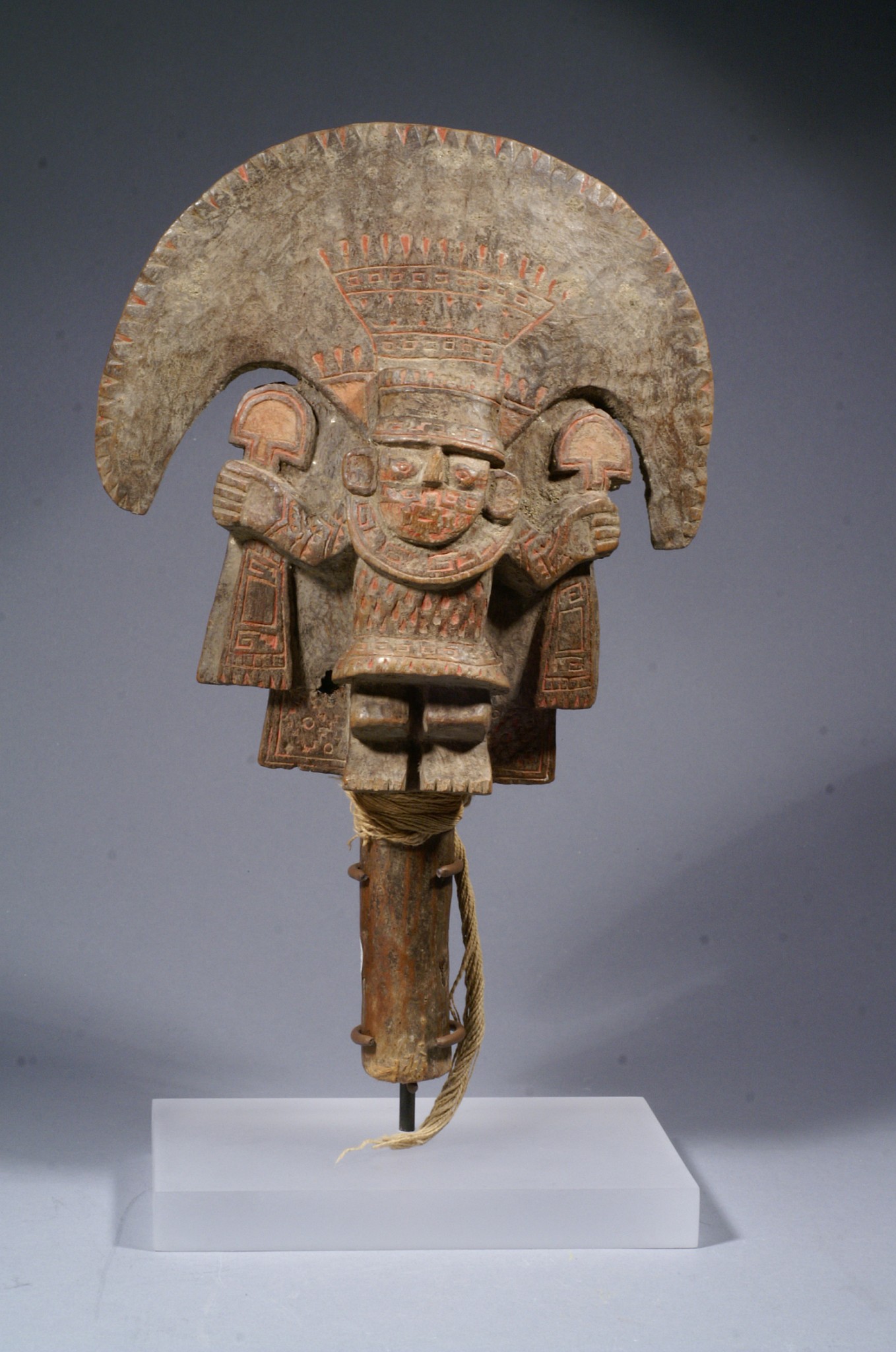



Peru, Chimu Wood Mirror Back depicting a lord
A large and well carved wood mirror back with a dignitary in full regaila wearing a nose ring and a large crescent shaped headdress. His face is also decorated with a tattoo. There is original cotton string bound to the handle. The pyrite mirror in the back is ancient but not original to the piece. A similar elaborate mirror back from the Chimu is illustrated in Alan Lapiner, "Pre-Columbian Art of South America" (1976: #625) That particular mirror was sold at Sotheby's auction May 19, 1993 for $30,000. My mirror was examined by Robert Sonin for authenticity May 25, 2006 Photo roll-out #3305 and #3306.
Period: Peru, Chimu, North Coast, circa AD900-1350
Media: Wood
Dimensions: Height 11"
Price Upon Request
98270










